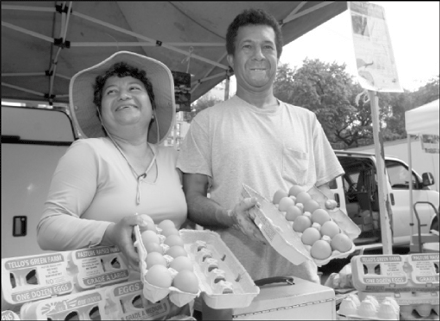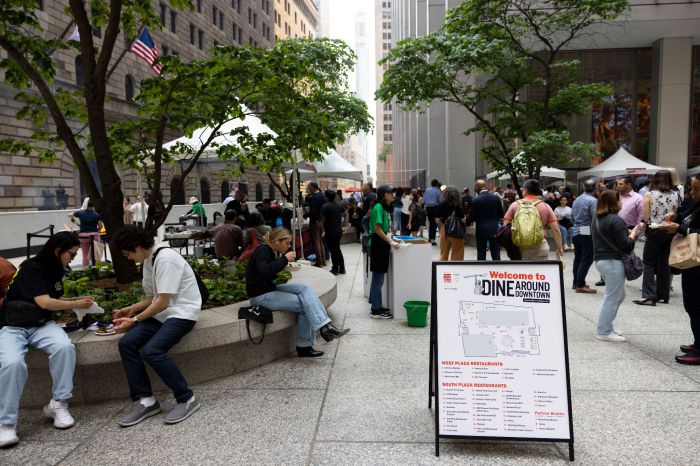By Alyssa Giachino
Nestled in a gray egg carton, half a dozen pale green eggs, each of which naturally displays a different hue on the scale from yellow to blue, are the demure centerpiece of a small booth at the Union Square Greenmarket.
The unique shell coloring comes from the Araucana hen, an heirloom variety originally from Chile. Nestor and Alejandra Tello raise these hens on their farm in Red Hook, N.Y., as their contribution to preserving the chickens’ unique bloodline. Most of the Tellos’ 2,000-bird flock are Rhode Island Red hens, whose eggs are a more conventional warm beige, but a handful of customers seek out the blue shells.
The Tellos are small-scale producers, raising their hens on a 5-acre piece of land about 100 miles from New York City. Their work is representative of a growing trend that portends the changing face of farming in the United States.
Over the last decade, both the number of farms in the United States and the number of farmers under the age of 65 have shrunk. Often the children of older farmers are not interested in taking over the family business, and are even discouraged by their parents because of the hardships involved. However, knowledge and experience brought by immigrants may begin to counter the backsliding of the family farm here.
Originally from Colombia, the Tellos are part of a growing demographic of farmers in the United States, namely immigrants and Latinos. Between 1997 and 2002, the number of Latino farmers grew by 50 percent, according to the Census of Agriculture.
“Many of these immigrants are coming from agrarian backgrounds and really want to be on the land farming,” said Alison Cohen, a regional director at Heifer International, an organization combating world hunger through agricultural development.
Another important trend has been the dramatic growth of greenmarkets that has forged a direct avenue for small producers to deliver high-quality produce to eager urban customers. It’s a symbiotic relationship that benefits both ends of the food-production chain.
“Greenmarkets create a marketing venue, infrastructure and support,” Cohen said. “It breaks down some of the isolation, because you get to know a community of farmers with similar goals.”
She emphasized that the proliferation of greenmarkets is driven by demand.
“It’s that level of consumer awareness that ultimately is going to drive the re-creation of these local food systems,” she said.
Since they started their farm in 2000, the Tellos have developed a loyal following of restaurateurs — who account for about a third of their business — and greenmarket customers, who altogether buy up to 10,000 eggs a week.
“The eggs have rich flavor and intense yolk color,” Alejandra said. “The difference is in the freshness and the way we raise the hens. We don’t use any product that isn’t natural.”
Nestor, 46, is emphatic about the hens’ diet, which he said gives the eggs a higher nutritional value, including a concentration of omega-3 fatty acids.
“We give them the basic staples they have eaten throughout history, which is corn, grass and what they find on the ground,” he said. He spoke disparagingly of agriculture’s industrialization after World War II, when chickens started being enclosed in cages and pumped full of hormones and antibiotics.
“When I have my hens free, I don’t need to give them extra vitamins, antibiotics or hormones because they already have that support naturally,” he said.
At the Union Square Greenmarket, customers flip through a photo album that sits next to the green eggs to see images of Nestor cradling a hen in his arms, of chickens running willy-nilly through the fields and of the domed chicken coop the Tellos built to house their flock.
A customer stopped by the booth asking for chicken breast meat on a recent Friday.
“We don’t have any yet,” Nestor said.
Turning the chickens into somebody’s dinner is Nestor’s least favorite part of the business.
“I don’t like to kill the hens, but people ask for the meat,” he said, shrugging. “In the summer we sell some. It’s good income and it satisfies one of man’s necessities.”
He said it makes sense to eliminate chickens from the flock when they grow old and don’t produce as many eggs, but he emphasized, “I don’t do it myself, I don’t even watch.”
“That’s the saddest part of this business for him,” said Alejandra, laughing, saying she is also sensitive, but more pragmatic about it.
Nestor has been attuned to the needs of animals since he was young. He worked with relatives on farms in Colombia, studied veterinary medicine, and operated a clinic serving livestock before moving to Brooklyn in 1992. He worked for many years in veterinary clinics and laboratories before he and Alejandra read about a farmer-training program in a Spanish-language newspaper.
A nonprofit organization, the New Farmer Development Project launched in 2000 to support immigrants who have experience in agriculture in starting their own farms. The organization, based in Manhattan, provides technical support, business management and marketing workshops and assistance in buying or leasing farmland. The Tellos were part of the first batch of graduates from the program.
The growth of their farm — from a starter group of 400 hens to 2,000 today — is mirrored by the growth of the program, which has trained more than 100 people, 14 of whom have started their own farm businesses.
“We’re not teaching people how to farm,” said Michelle Hughes, a project associate. “We’re assuming they already know. But how to find credit opportunities, how to find land, how to find equipment, how to deal with weather and winter, because some people aren’t familiar with seasons.”
The U.S. Department of Agriculture has focused more attention on immigrant farmers in the last five years through loans and support administered by its Risk Management Agency.
“There has been a lot more funding available to immigrant farmers,” said Cohen, of Heifer International.
The New Farmer Development Project encourages entrepreneurship, something of a novelty in agriculture, where immigrants have long been a source of cheap labor but rarely owners. In California, Asian immigrants, particularly Hmong refugees, are making their mark as producers. In the Northeast, farm projects already underway include Puerto Ricans, other Latinos and Somali refugees.
Nestor admits that many people assume he works for somebody else.
“It’s an American idiosyncrasy,” he said. “People are taught to think that the business belongs to a white man. But when they realize that you are the owner, they are pleased.
“It’s nice, because some buy because they like the product, others because they want to support us,” he said. “The two things go hand in hand.”
Though he said it’s satisfying to run his own farm, hardships are woven into the experience.
“I’m doing something I always wanted to do since a very early age,” he said. “It’s hard. Day by day one is learning how to manage things.”
The Tellos have help on their farm from two Central American workers and, when he’s not too busy being an adolescent, their 14-year-old son. Nestor said he feels more like a collaborator than a boss.
“It has always been the case that we are doing something in conjunction with the customers, the workers, the Greenmarket management,” he said.
“And the hens,” added Alejandra. “They are the most important.”














